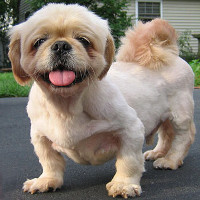Appearance of the Lhasanese
|
| The exact appearance of the Lhasanese will closely resemble that of the parent Lhassa Apso, however, its exact appearance will depend on the dominant parent breed. Generally speaking, they have long, flowing, silky hair. They are small dogs, often weighing no more than 11.5 kilos at maturity. They generally measure 28 centimetres at the withers. It can come in a variety of colors, but is often the same as its parent Lhassa Apso. These colors include honey, black, white, slate or particolored. However, it can also be golden, like its parent breed Pekingese. It will have a slender body and a long tail that curls over its back. |
Temperament of the Lhasanese
|
| The Lhasanese is a friendly, affectionate dog. He is loyal and loves all members of his family, including children. He is patient with small children, but it is recommended that he be socialized with other dogs from an early age. With socialization, the Lhasanese can learn what behavior you expect from him. He can be a bit of a guard dog and is known to be wary of strangers. He's not an active dog and prefers to spend time cuddling you on the sofa. He doesn't tend to suffer from separation anxiety, but will follow you from room to room as you move around the house. |
Needs and activities of the Lhasanese
|
| The Lhasanese is not a very active dog. If he's happy to accompany you on a short walk or to the dog park, he's just as happy to sit on your lap. He's happy to live in an apartment or house with a fenced-in yard, however, bear in mind that Lhasanese can suffer from brachycephalic syndrome if he inherits the flattened face of the parent breed Pekingese. With this health problem, a dog can't be allowed to overexert himself, or get too hot. It's always a good idea for a brachycephalic dog to have access to enough water. If the Lhasanese were overheated or overexcited, it might not be able to breathe properly. For this reason, Lhasanese do best in short periods of activity. |
Maintenance of the Lhasanese
|
| The Lhasanese needs the same care as its parent breed, the Lhassa Apso. It will need frequent brushing, sometimes daily, to maintain its coat and avoid knots. Some owners have been known to trim their Lhasanese's coat so that maintenance can be kept to a minimum. Trim your Lhasanese's nails once every two weeks. As a general rule, if you hear the nails rattling on your floor, it's time to trim them. Brush his teeth two or three times a week to prevent bad breath. If you want to prevent tooth decay, brush his teeth daily. Bear in mind that small dogs are more likely to develop tooth decay. |









 English (United Kingdom)
English (United Kingdom)